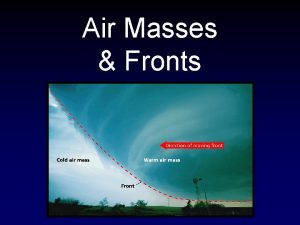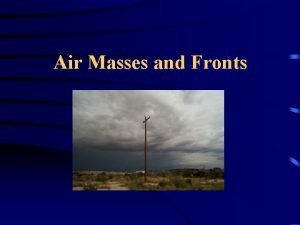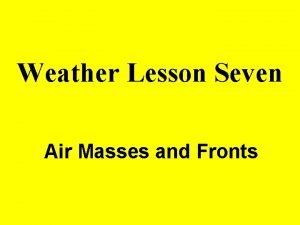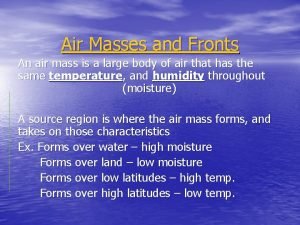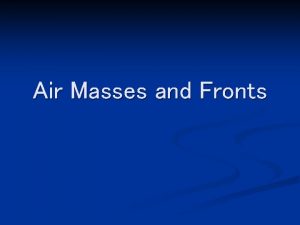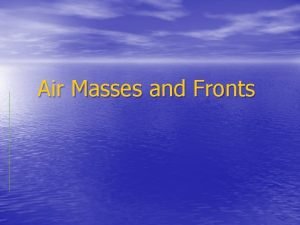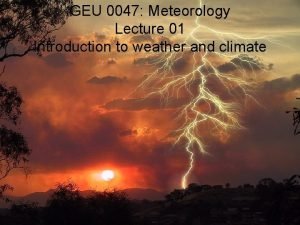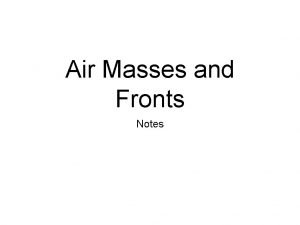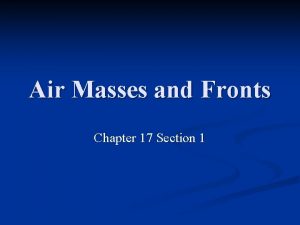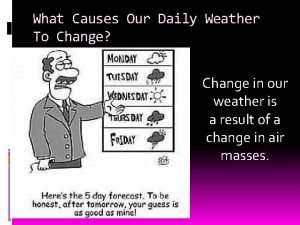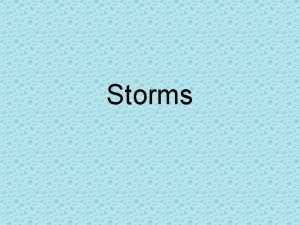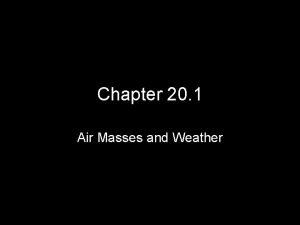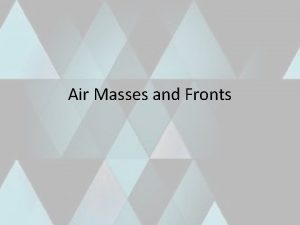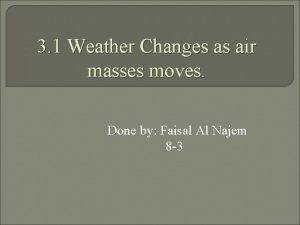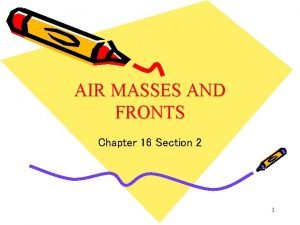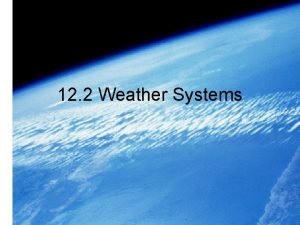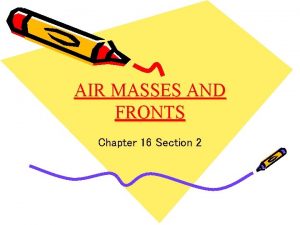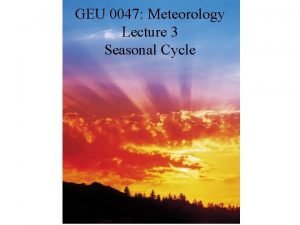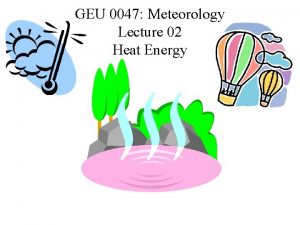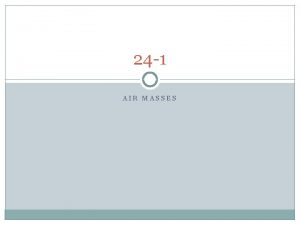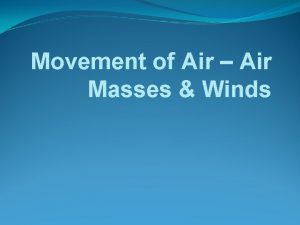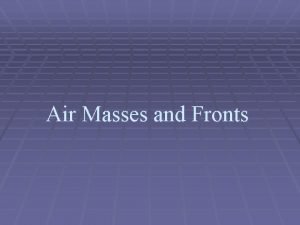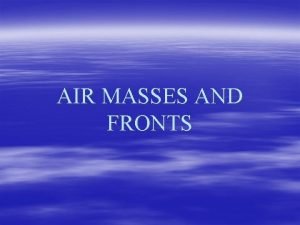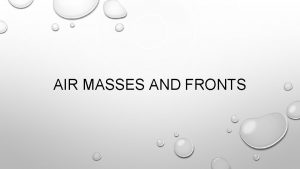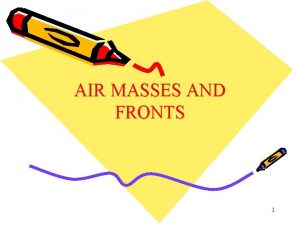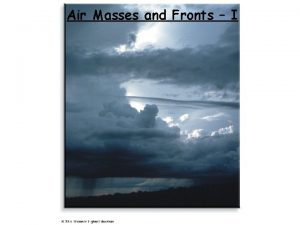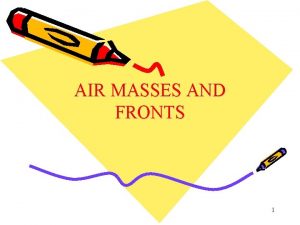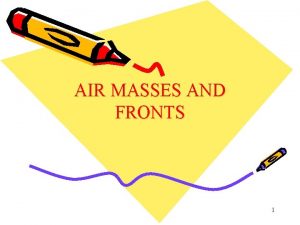GEU 0047 Meteorology Lecture 11 Air Masses and



































- Slides: 35

GEU 0047: Meteorology Lecture 11: Air Masses and Fronts

Air Masses • the air with similar properties of temperature and moisture which covers a large area • Semi-permanent structures in the atmosphere

Air Mass Classifications • Moisture content – Dry – Moist Continental (c) Marine (m) • Temperature – Cold – Warm Polar (P), Tropical (T), Arctic (A) • Results in 5 basic types – c. A – c. P – c. T – Continental Arctic Continental Polar Continental Tropical m. P m. T Marine Polar Marine Tropical

Global air mass source regions

Air Mass Source Regions

Source Region Profiles

Arctic Air (c. A) • Arctic Air Mass – Bitterly Cold and Usually Very Dry – Develops over the snow or ice covered regions of continents – Similar to polar air masses but usually develops in regions north of 60 N where there is little or no insolation during the winter.

Continental Polar (c. P) • Continental Polar Air Mass – Cold, Dry – Develops over the interior of • North America -- Central Canada -- Siberia

Marine Polar (m. P) • Marine Polar Air Mass – Cold, Moist – Develops over the cold ocean waters of the North Pacific and North Atlantic • Usually associated with conversion of c. P siberian air to m. P which is moistened and warmed from the Japanese “Gulf Stream Current” • Moves across the N. Pacific to affect N. California and the Pacific NW • Responsible for fueling “Nor-easters”

Tropical (T) • Continental Tropical (c. T) – Hot, Dry – Develops over the deserts of Mexico and the Southwestern United States – Very unstable because of heat and convection, but cloudless because of lack of moisture. • Marine Tropical (m. T) – Warm, Humid – Develops over the tropical and subtropical oceans and the Gulf of Mexico

Example Air Masses c. P m. T

Air Mass Modification • Air masses do not always remain over their source regions. • If the air moves over a region that is different from where it originated, the air mass will be modified, or changed, by the land/ocean surface that the air is travelling over. • Changes include: warming, cooling, adding or reducing moisture content

Air Mass Modification c. P The c. P air mass will be warmed by the warmer land that it passes over. Warmer Land

Air Mass Invasion

Air Mass Invasion

Air Mass Invasion

Changes in Stability Cold air mass moves over a warmer surface. c. P The lower layers are warmed and may become unstable. Warm, Moist

Stability Changes Dry Adiabat Moist Adiabat Environment Cold air mass moving over a warmer surface. Altitude (m) Temperature ( C) Sounding Before Modification: Conditionally Unstable Altitude (m) Temperature ( C) After modification: Absolutely Unstable

Stability Changes Warm air mass moves over a colder surface. m. T Warm, Moist The lower layers are cooled and tend to stablize. Cold

Stability Changes Dry Adiabat Moist Adiabat Environment Warm air mass moves over a colder surface. Altitude (m) Temperature ( C) Sounding Before Modification: Conditionally Unstable Altitude (m) Temperature ( C) After modification: Absolutely stable

Frontal Boundary Symbols

Fronts

Fronts • Front – A narrow transition zone between air masses of differing densities. – The density differences usually arise from temperature differences. – Density differences may be a result of humidity differences (summer). • A front is the boundary or transition zone between different air masses.

Air Mass Invasion • The transition zone is usually narrow (15 to 200 km in width). • Frontal Boundaries may be over 1000 km long. • On maps, we draw the frontal boundary on the warm side of the transition zone.

Idealized Cold Front • Cold Front – A boundary that moves in such a way that the colder (more dense) air advances and displaces the warmer (less dense) air. – The largest temperature differences are normally associated with cold fronts.

Idealized Cold Front Cross-sectional Characteristics Warm Air Cold Air Strong Lifting near the frontal boundary can produce convective clouds.

Idealized Cold Front

Idealized Cold Front • Precipitation: – Located on either side of the front. – Convective, showery in nature – If warm air is stable • Nimbostratus, Altostratus – If warm air is unstable • Cumulus, Cumulonimbus, Thunderstorms

Weather conditions associated with a cold front Weather Phenomenon Prior to the Passing of the Contact with the Front After the Passing of the Front Temperature Warm Cooling suddenly Cold and getting colder Atmospheric Pressure Decreasing steadily Leveling off then increasing Increasing steadily Winds South to southeast Variable and gusty West to northwest Precipitation Showers Heavy rain or snow, Showers then clearing hail sometimes Clouds Cirrus and cirrostratus changing later to cumulus and cumulonimbus Cumulus

Idealized Warm Front • Warm Front – A boundary that moves in such a way that the colder (more dense) air retreats and is replaced by the warmer (less dense) air. – The warm fronts tend to have weaker temperature gradients.

Idealized Warm Front

Weather conditions associated with a warm front Weather Phenomenon Prior to the Passing of the Contact with the Front After the Passing of the Front Temperature Cool Warming suddenly Warmer then leveling off Atmospheric Pressure Decreasing steadily Leveling off Slight rise followed by a decrease Winds South to southeast Variable South to southwest Precipitation Showers, snow, sleet or drizzle Light drizzle None Clouds Cirrus, cirrostratus, altostratus, nimbostratus, and then stratus Stratus, sometimes cumulonimbus Clearing with scattered stratus, sometimes scattered cumulonimbus

Occluded Front • Cold fronts typically move faster than warm fronts. • Cold fronts can catch up and “overtake” a warm front. • Depending on the different air masses, there are two types of occlusions: – Cold type occlusion – Warm type occlusion

Cold-type Occlusion when the air behind the front is colder than the air ahead of the front. Warm Air Cold Air Cool Air Cold type occlusions are common on the east coast of continents and generally form when the continental polar or arctic air collides with maritime subtropic air.

Warm-type Occlusion When the air behind the front is warmer than the air ahead of the front Warm Air Cool Air Cold Air Warm type occlusions are common on the west coast of continents and generally form when maritime polar air collides with continental polar or arctic air.
 Two cold air masses converge on a warm air mass
Two cold air masses converge on a warm air mass Cold front air movement
Cold front air movement Air masses & frontswhat is an air mass?
Air masses & frontswhat is an air mass? The boundary between two adjacent air masses is called
The boundary between two adjacent air masses is called A swirling center of low air pressure is called
A swirling center of low air pressure is called Air masses & frontswhat is an air mass?
Air masses & frontswhat is an air mass? Air masses & frontswhat is an air mass?
Air masses & frontswhat is an air mass? Air masses & frontswhat is an air mass?
Air masses & frontswhat is an air mass? Knots si unit
Knots si unit Air masses and their characteristics
Air masses and their characteristics Area of low pressure where air masses meet and rise
Area of low pressure where air masses meet and rise What are middle-latitude cyclones?
What are middle-latitude cyclones? Types of fronts
Types of fronts Air masses form in the tropics and have low pressure
Air masses form in the tropics and have low pressure North american air masses
North american air masses Modern earth science
Modern earth science Air masses in north america
Air masses in north america Jet stream map
Jet stream map Occluded front symbol
Occluded front symbol Large rotating air mass
Large rotating air mass Importance of air masses
Importance of air masses Types of air masses
Types of air masses Cyclogenesis occurs along the________.
Cyclogenesis occurs along the________. Continental polar symbol
Continental polar symbol Types of air masses
Types of air masses Air masses map
Air masses map Tropical air masses
Tropical air masses Air mass modification
Air mass modification What are the five types of air masses?
What are the five types of air masses? Air mass mt
Air mass mt Air masses
Air masses Air masses
Air masses What is coriolis effect caused by
What is coriolis effect caused by Warm front diagram
Warm front diagram Air masses
Air masses Front
Front

